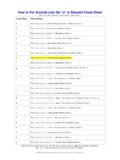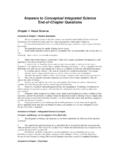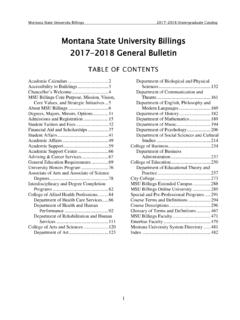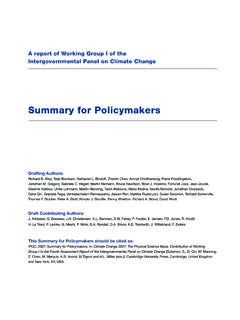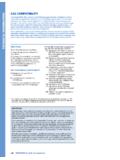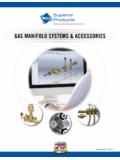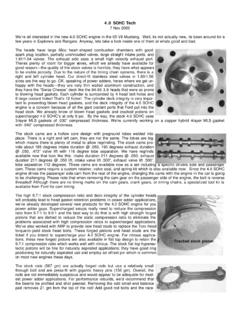Transcription of Multiple Choice Exam Questions Chapter 1
1 Multiple Choice Exam Questions Chapter 1 1. The primary source of energy for the earth's atmosphere is: a. energy from within the earth b. the sun c. erupting volcanoes d. lightning discharges associated with thunderstorms e. latent heat released during the formation of hurricanes ANSWER: b 2. The most abundant gases in the earth's atmosphere by volume are: a. carbon dioxide and nitrogen b. oxygen and water vapor c. nitrogen and oxygen d. oxygen and helium e. oxygen and ozone ANSWER: c 4. Water vapor is: a.
2 A gas b. a cloud droplet c. a rain drop d. a snowflake ANSWER: a 7. Which of the following is considered a variable gas in the earth's atmosphere? a. water vapor b. nitrogen c. oxygen d. argon ANSWER: a 8. The gas that shows the most variation from place to place and from time to time in the lower atmosphere: a. ozone (O3) b. carbon dioxide (CO2) c. water vapor (H2O) d. methane (CH4) e. argon (Ar) ANSWER: c 12. In the atmosphere, tiny solid or liquid suspended particles of various composition are called: a.
3 Aerosols b. carcinogens c. greenhouse gases d. microbes ANSWER: a 13. The most abundant greenhouse gas in the earth's atmosphere: a. carbon dioxide (CO2) b. nitrous oxide (N2O) c. water vapor (H2O) d. methane (CH4) e. chlorofluorocarbons (CFCs) ANSWER: c 17. Which of the following processes acts to remove carbon dioxide from the atmosphere? a. lightning b. deforestation c. photosynthesis d. burning fossil fuels ANSWER: c 19. The earth's first atmosphere was composed primarily of: a. carbon dioxide and water vapor b.
4 Hydrogen and helium c. oxygen and water vapor d. argon and nitrogen ANSWER: b 21. The most abundant gas emitted from volcanoes is: a. nitrogen b. sulfur dioxide c. helium d. carbon dioxide e. water vapor ANSWER: e 23. This holds a planet's atmosphere close to its surface: a. radiation b. gravity c. cloud cover d. moisture e. pressure ANSWER: b 24. The amount of force exerted over an area of surface is called: a. density b. weight c. temperature d. pressure ANSWER: d 25. Much of Tibet lies at altitudes over 18,000 feet where the pressure is about 500 mb.
5 At such altitudes, the Tibetans are above roughly: a. 10% of the air molecules in the atmosphere b. 25% of the air molecules in the atmosphere c. 50% of the air molecules in the atmosphere d. 75% of the air molecules in the atmosphere ANSWER: c 28. Which of the following weather elements always decreases as we climb upward in the atmosphere? a. wind b. temperature c. pressure d. moisture e. all of the above ANSWER: c 32. The gas responsible for the greenhouse effect on Venus: a. carbon dioxide (CO2) b. oxygen (O2) c.
6 Ozone (O3) d. nitrogen (N2) e. water vapor (H2O) ANSWER: a 33. The planet with a strong greenhouse effect, whose surface temperature averages 480 oC (900 oF): a. Earth b. Venus c. Mars d. Pluto ANSWER: b 35. The earth's atmosphere is divided into layers based on the vertical profile of: a. air pressure b. air temperature c. air density d. wind speed ANSWER: b 37. Almost all of the earth's weather occurs in the: a. exosphere b. stratosphere c. mesosphere d. thermosphere e. troposphere ANSWER: e 39. The hottest atmospheric layer is the: a.
7 Stratosphere b. mesosphere c. thermosphere d. troposphere ANSWER: c 41. The atmospheric layer in which we live is called the: a. troposphere b. stratosphere c. thermosphere d. ionosphere e. exosphere ANSWER: a 43. The instrument that measures temperature, pressure, and humidity at various altitudes in the atmosphere: a. barograph b. radiosonde c. aneroid barometer d. altimeter ANSWER: b 44. Warming in the stratosphere is mainly caused by: a. absorption of ultraviolet radiation by ozone b. release of latent heat energy during condensation c.
8 Chemical reactions between ozone and chlorofluorocarbons d. frictional heating caused by meteorites ANSWER: a 45. In a temperature inversion: a. air temperature increases with increasing height b. air temperature decreases with increasing height c. air temperature remains constant with increasing height d. it is warmer at night than during the day ANSWER: a 46. The rate at which temperature decreases with increasing altitude is known as the: a. temperature slope b. lapse rate c. sounding d. thermocline ANSWER: b 49.
9 The electrified region of the upper atmosphere is called the: a. thermosphere b. mesosphere c. stratosphere d. ionosphere e. troposphere ANSWER: d 52. The gas that absorbs most of the harmful ultraviolet radiation in the stratosphere: a. water vapor b. nitrous oxide c. carbon dioxide d. ozone e. chlorofluorocarbons ANSWER: d 55. Which latitude belt best describes the middle latitudes? a. 20o to 80o b. 10o to 35o c. 20o to 35o d. 40o to 70o e. 30o to 50o ANSWER: e 58. The wind direction is: a. the direction from which the wind is blowing b.
10 The direction to which the wind is blowing c. always directly from high toward low pressure d. always directly from low toward high pressure ANSWER: a 77. In an average year, more people die from this than from any other natural disaster. a. lightning b. earthquakes c. tornadoes d. flash floods and flooding e. droughts ANSWER: d Chapter 2 1. Which of the following provides a measure of the average speed of air molecules? a. pressure b. temperature c. density d. heat ANSWER: b 3. Which of the following is not considered a temperature scale?
